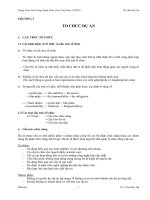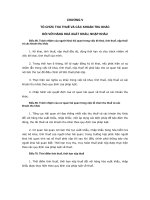chương 3 tổ chức cơ cấu và văn hóa
Bạn đang xem bản rút gọn của tài liệu. Xem và tải ngay bản đầy đủ của tài liệu tại đây (645.55 KB, 30 trang )
McGraw-Hill/Irwin
© 2008 The McGraw-Hill Companies, All Rights
Reserved
Organization:
Structure and
Culture
Chapter 3
3-2
3-3
Project Management Structures
Challenges to Organizing Projects
The uniqueness and short duration of projects relative
to ongoing longer-term organizational activities
The multidisciplinary and cross-functional nature of
projects creates authority and responsibility
dilemmas.
Choosing an Appropriate Project
Management Structure
The best system balances
the needs of the project
with the needs of the
organization.
3-4
Project Management Structures
Organizing Projects: Functional
organization
Different segments of the project are
delegated to respective functional units.
Coordination is maintained through normal
management channels.
Used when the interest of one functional area
dominates the project or one functional area has
a dominant interest in the project’s success.
3-5
Functional Organizations
FIGURE 3.1
3-6
Functional Organization of Projects
Advantages
No Structural
Change
Flexibility
In-Depth
Expertise
Easy Post-Project
Transition
Disadvantages
Lack of Focus
Poor Integration
Slow
Lack of
Ownership
3-7
Project Management Structures (cont’d)
Organizing Projects: Dedicated Teams
Teams operate as separate units under the
leadership of a full-time project manager.
In a projectized organization where projects
are the dominant form of business, functional
departments are responsible for providing
support for its teams.
3-8
Dedicated Project Team
FIGURE 3.2
3-9
Project Organization: Dedicated Team
Advantages
Simple
Fast
Cohesive
Cross-Functional
Integration
Disadvantages
Expensive
Internal Strife
Limited
Technological
Expertise
Difficult Post-
Project Transition
3-10
Project Organizational Structure
FIGURE 3.3
3-11
Project Management Structures (cont’d)
Organizing Projects: Matrix Structure
Hybrid organizational structure (matrix) is overlaid
on the normal functional structure.
o
Two chains of command (functional and project)
o
Project participants report simultaneously to both
functional and project managers.
Matrix structure optimizes the use of resources.
o
Allows for participation on multiple projects while
performing normal functional duties
o
Achieves a greater integration of expertise and
project requirements
3-12
Matrix Organization Structure
FIGURE 3.4
3-13
Division of Project Manager and
Functional Manager Responsibilities
in a Matrix Structure
TABLE 3.1
Project Manager Negotiated Issues Functional Manager
What has to be done? Who will do the task? How will it be done?
When should the task be done? Where will the task be done?
How much money is available to Why will the task be done? How will the project involvement
do the task? impact normal functional activities?
How well has the total project Is the task satisfactorily How well has the functional
been done? completed? input been integrated?
3-14
Different Matrix Forms
Functional (also Weak or Lightweight) Form
Matrices in which the authority of the functional
manager predominates and the project manager has
indirect authority
Balance (or Middleweight) Form
The traditional matrix form in which the project
manager sets the overall plan and the functional
manager determines how work to be done
Strong (Heavyweight) Form
Resembles a project team in which the project
manager has broader control and functional
departments act as subcontractors to the project
3-15
Project Organization: Matrix Form
Advantages
Efficient
Strong Project
Focus
Easier Post-
Project Transition
Flexible
Disadvantages
Dysfunctional
Conflict
Infighting
Stressful
Slow
3-16
Rated Effectiveness of Different
Project Structures by Type of Project
FIGURE 3.5
Source: Larson, E. W., and Gobeli, D. H., “Matrix Management: Contradictions and
Insights,” California Management Review, vol. 29, no. 4 (Summer 1987), p. 137.
3-17
Choosing the Appropriate
Project Management Structure
Organization (Form) Considerations
How important is the project to the firm’s
success?
What percentage of core work involves
projects?
What level of resources
(human and physical)
are available?
3-18
Choosing the Appropriate Project
Management Structure (cont’d)
Project Considerations
Size of project
Strategic importance
Novelty and need for innovation
Need for integration (number of departments
involved)
Environmental complexity (number of external
interfaces)
Budget and time constraints
Stability of resource requirements
3-19
Organizational Culture
Organizational Culture Defined
A system of shared norms, beliefs, values,
and assumptions which bind people together,
thereby creating shared meanings
The “personality” of the organization that sets
it apart from other organizations.
o
Provides a sense of identify to its members
o
Helps legitimize the management system of the
organization
o
Clarifies and reinforces standards of behavior
3-20
Key Dimensions Defining an
Organization’s Culture
FIGURE 3.6
3-21
Identifying Cultural Characteristics
Study the physical characteristics of an
organization.
Read about the organization.
Observe how people interact within the
organization.
Interpret stories and folklore surrounding
the organization.
3-22
Organizational Culture Diagnosis
Worksheet
FIGURE 3.7
3-23
Implications of Organizational Culture
for Organizing Projects
Navigating Organizational Cultures:
Working Upstream or Downstream?
Interacting with the culture and subcultures of
the parent organization
Interacting with the project’s clients or
customer organizations
Interacting with other
organizations connected
to the project
3-24
Cultural Dimensions of an Organization
Supportive of Project Management
FIGURE 3.8
3-25
Key Terms
Balanced matrix
Dedicated project team
Strong matrix
Matrix
Organizational culture
Weak matrix
Projectitis
Projectized organization









